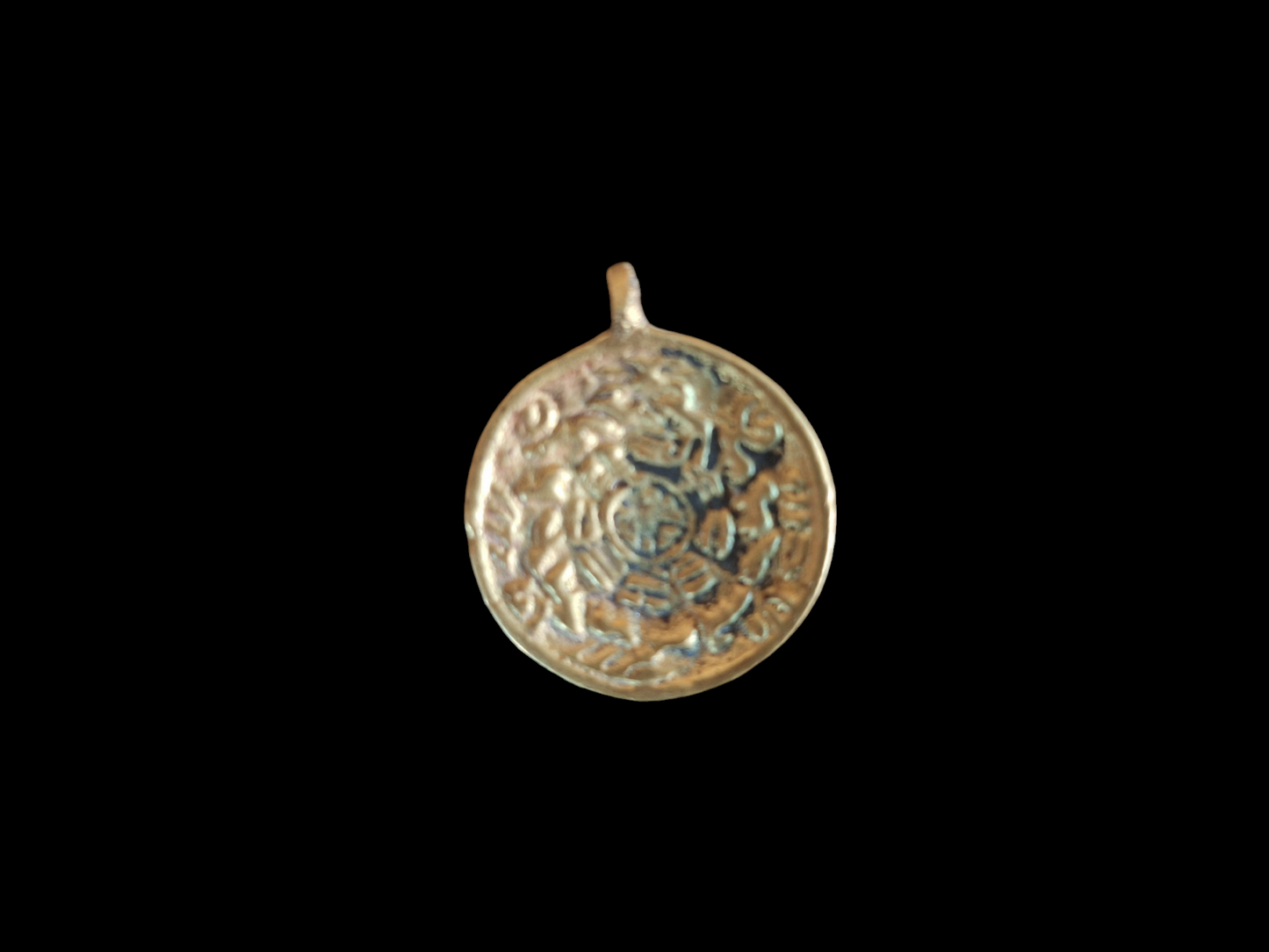Seawolf Shop
Vintage Nepalese melong Double Dorje and Si Pa Ho 28 millimeters
Vintage Nepalese melong Double Dorje and Si Pa Ho 28 millimeters
Couldn't load pickup availability
Share
Vintage brass mirror from Nepal with a diameter of 28 millimeters (measured without the eyelet). In Nepal, mirrors such as these are called 'melong'. They are traditionally often worn on the belt, instead of around the neck.
Design characteristics:
This melong is decorated on both sides. On the frontside, the symbol of a double dorje can be seen.
The word 'dorje' (or in Sanskrit 'vajra') translates both as 'lightning bolt' and as 'diamond'. It is a widespread symbol in both buddhism and hinduism, and can be found on for example depictions and statues of the buddha, decorations on ritual attributes, furniture and fabrics.
The dorje symbolizes the true nature of the universe and reality; the endless, ultimate emptiness in which all possibilities exist. The dorje (as a visual symbol and/or physical attribute) is often used during meditation practices, to support in 'cutting through the crap of the mind', finding a clear path through the diversions of the 'monkey-mind' and ego-chatter, seeing what's real and what's not. The dorje is said to destroy all kinds of ignorance and in this way helps in gaining true insights.
This melong shows a 'double dorje' or 'crossed dorje'; from the central hub there are dorje-heads going into all four cardinal directions. This symbolizes the principle of absolute stability, of finding solid ground in the middle of the universe. It is said that a vast crossed dorje underlies Mount Meru, the esoteric mountain in Hindu and Buddhist cosmology that is considered to be the centre of all universes. Thus the double dorje supports the entire physical universe. Also a double dorje is often depicted as the central hub of intricate mandala representations, such as in thangka’s, where it forms the immoveable support or foundation of the mandala palace.
On the backside of this mirror, a depiction of the traditional Tibetan astrological system can be seen; the astrological chart of Si Pa Ho, consisting of three schematic images:
1) In the center the mystical square Me Wa Gu can be seen. In the 9 parts the numbers from 1 to 9 are inscribed, the sum of which in each column is 15. This scheme forms in Tibetan-Mongolian astrology a numerological indication of the relationship between a person and deities and spirits. Each digit governs the year, they replace each other in reverse order.
In China this mystical square has been known since 2200 BCE and is called 'Lo Shu' or Nine Halls diagram; it derives from ancient Chinese mathematical and divination traditions, such as the art of Taoist Geomancy. Nowadays it is also widely known as an important emblem in Feng Shui; the 9 parts (also called 'palaces') then represent the 8 directions of the compass plus the central position, with each part having its own energy.
2) In the ring around the square the 8 trigrams ('Ba Gua') of Par Ha Ge can be seen. The trigram symbols come from very ancient origin; they derive from symbols found on ancient Chinese divination bones dating back as long as 11th century BCE. A related version of bone oracle is still used today by Turkic and Mongolian people, and also in the lineage of Spirit of Wolf Shamanism; 'Khaziki'.
Doubled trigrams form 64 hexagrams, which form the core of the I Ching, the Book of Changes.
Each trigram is a divinatory grapheme and represents different dynamics, energies, cardinal points, animals, seasons etc. In depictions such as on these mirrors, where the 8 of them together form a circle, it symbolizes heavenly order, a healthy balance and right flow of energy.
3) In the outer ring the 12 animals of the eastern zodiac can be seen. Just like the circular arrangement of the trigrams, also this motive adds to the idea of heavenly order. But also its presence, when used on shamanic mirrors, symbolizes control over time and space, an important core principle in the practice of shamanism.
Read more about the origin, design and usage of (shamanic) mirrors in the general description of our webshop collection "Mirrors and Melongs".



